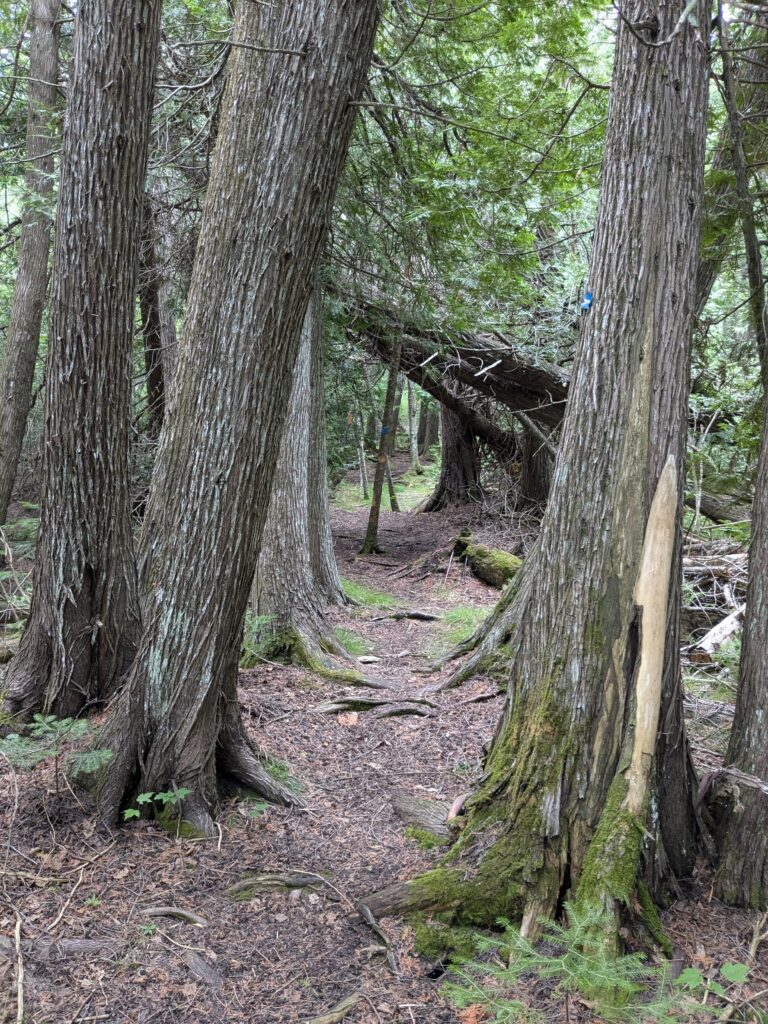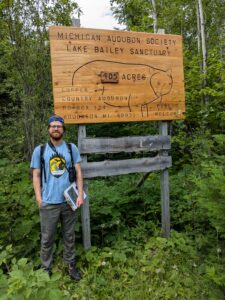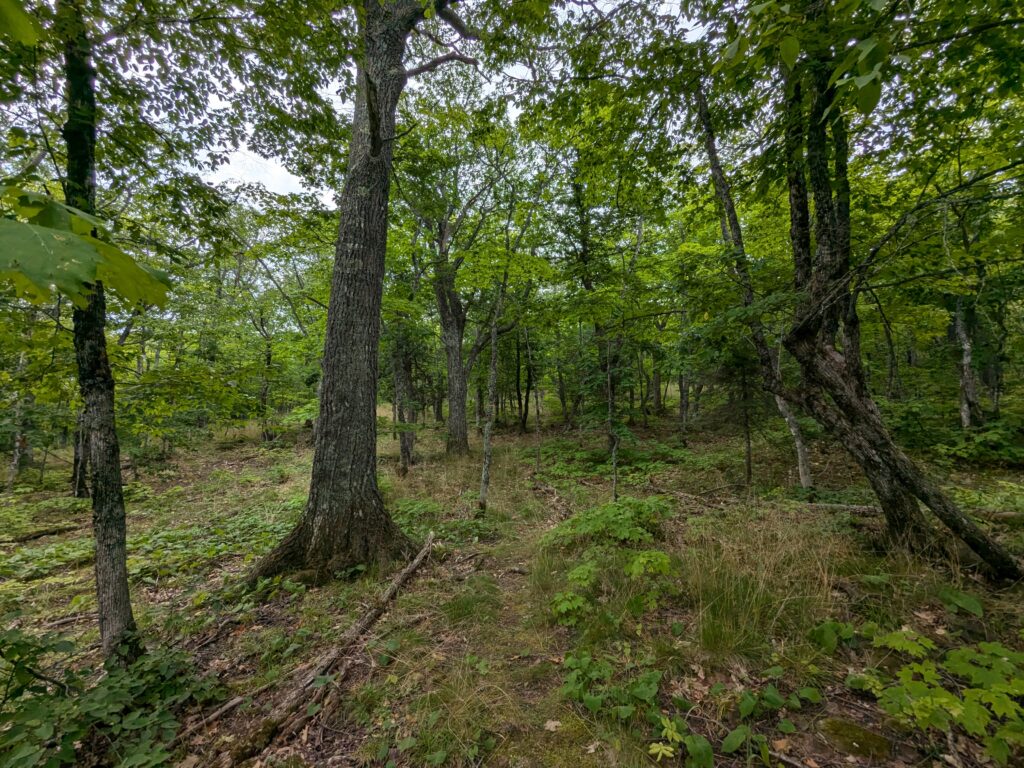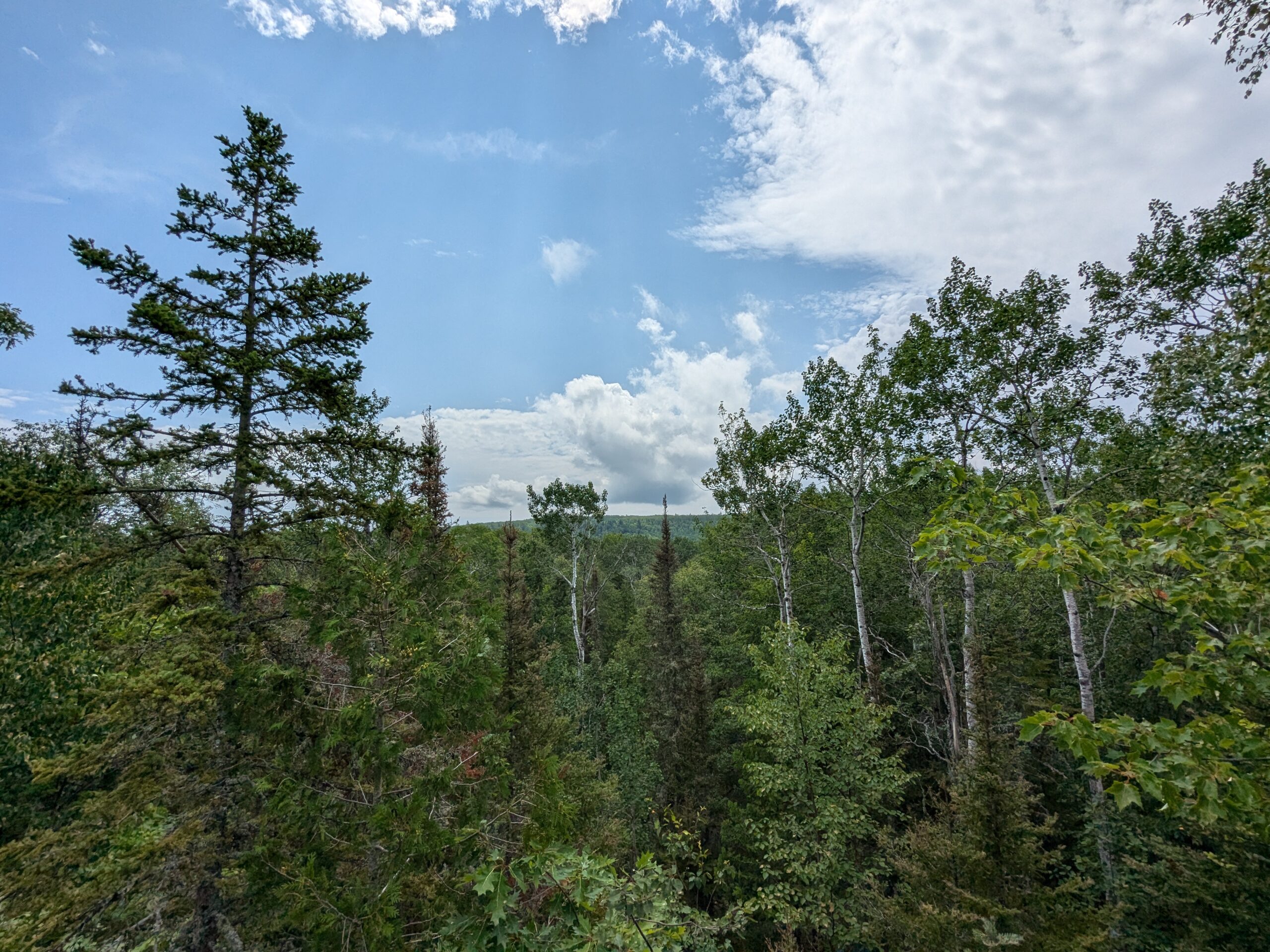Conservation Manager Chad Machinski, M.S., joined the Michigan Audubon team in March of 2023 and has made great progress in reviving the stewardship of MA’s sanctuaries and engaging with our dedicated volunteers ever since. To help you stay connected with the work being done, he will be presenting regular online updates about activities going on at them: birds seen or heard, conservation work, improvements, interesting plants, and more.
Summer has moved along at a rapid pace. Fortunately, I was able to make time to visit two of our northernmost bird sanctuaries, Lake Bailey and Brockway Mountain Drive, at the end of July.
LAKE BAILEY SANCTUARY
Located between Eagle Harbor and Copper Harbor in Keweenaw County, Lake Bailey Sanctuary and Brockway Mountain Drive are not only our northernmost but our third and fourth largest sanctuaries, coming in at 405 and 395 acres, respectively. Lake Bailey Sanctuary sits just east of Lake Bailey itself. It consists primarily of rich conifer swamp but increases in elevation immensely, giving way to drier soils sitting over bedrock with spruces, firs, and red oak. While it was eerily quiet for the majority of the hike, on our way out, a flock of Black-capped Chickadees came through with an assortment of other birds such as Black-throated Green Warbler, Black-throated Blue Warbler, Red-breasted Nuthatch, and Brown Creeper, lending credence to the idea that where there are chickadees, there will be warblers and more.

Trail in Lake Bailey Sanctuary through cedar swamp. Photo by Chad Machinski

Chad Machinski next to Lake Bailey Sanctuary Sign. The sign was recently refinished by the Carlson family. Photo by Murphy Harrington

At higher elevations of the Lake Bailey Sanctuary, the natural community changes and has more red oaks. Photo by Chad Machinski
BROCKWAY MOUNTAIN DRIVE SANCTUARY
After the hike through Lake Bailey Sanctuary, a trip to the Brockway Mountain Drive Sanctuary was made. While many folks who have visited this area are likely familiar with the Brockway Mountain Overlook, our sanctuary is west of this oft-visited location. The sanctuary consists of thin soils over rock and is made up of mixed hardwoods and conifers. A Ruby-throated Hummingbird greeted us at the trailhead, and a pair of Broad-winged Hawks met us on the trail with their high-pitched “keeeEEee” call. The Krumm family takes care of this trail, named after their son, Oren Krumm, who originally developed it.
Despite the extreme northern extent of these sanctuaries, they do receive regular care. These properties have been added on to and maintained by the Copper Country Audubon, a chapter of Michigan Audubon. Without Copper Country Audubon and the help of neighbors, these sanctuaries would not be what they are, and I have immense gratitude for the people who have helped to protect this land in such a beautiful part of Michigan.

Chad Machinski next to Brockway Mountain Drive Sanctuary sign. Photo by Murphy Harrington
The following day was a day spent in the Houghton-Hancock area. I had the fortunate opportunity to meet with Copper Country Audubon President Dana Richter, Treasurer Bill Deephouse, and Vice President Joe Youngman. It was great being able to meet with the leaders of our northernmost chapter. As stated above, this chapter has been instrumental in land protection for Michigan Audubon and the management of these sites. Beyond the work they have done for the sanctuaries, the chapter also does great work with their own research in the Keweenaw Peninsula, such as acoustic monitoring of migrating warblers, Trumpeter Swan surveys, several migration counts, and more.
In addition, I was able to get together with Michigan Audubon Board Member Dr. David Flaspohler, who also serves as Dean at the College of Forest Resources and Environmental Science at Michigan Technological University. David shared a story of being able to see a natural Chimney Swift nest several years ago inside a dead and hollow spruce tree, a unique opportunity for which I hope to one day see myself.

High point at Brockway Mountain Drive Sanctuary. Photo by Chad Machinski
CHIMNEY SWIFTS
Speaking of Chimney Swifts…being able to spend some time in towns I had only previously visited once, I was able to add potential roosting sites to the Chimney Swift roost map in Copper Harbor, Hancock, Houghton, Calumet, and later, Manistique. While I wasn’t able to detect active roosts, and nesting season that far north probably just wrapped as I arrived, I was able to see about seven Chimney Swifts in Hancock that possibly were a family unit, and I was able to see two Chimney Swifts in Copper Harbor in town and over Lake Fanny Hooe. These swifts in Copper Harbor mark the northernmost Chimney Swifts I have ever seen in Michigan.
As this blog comes out, swift migration is underway in Michigan. The northern sections of our state are likely seeing some of the biggest roosts this week, and the southern part of the state may still have large spectacles. Please get out to your local known roosts in the next couple of weeks and submit your observations to our Roost Survey Tool. If you are in the vicinity of Hastings, Lansing, or Spring Arbor, please join us on August 23, 24, and 25, respectively, for a Swift Night Out event where we will meet at historically known roosting sites to observe swifts roosting for the night.
To learn more about Michigan Audubon sanctuaries, visit michiganaudubon.org/conservation/bird-sanctuaries. If you want to volunteer at a Michigan Audubon sanctuary, please complete the Sanctuary Volunteer Interest Form.

Chad Machinski, MS
Conservation Manager
While Chad’s first love is botany, he doesn’t deny the intertwining nature of birds, plants, insects, and all other organisms we share the world with. His passion for the natural world began in his undergraduate time at the University of Michigan, taking several different forms along the way. His graduate studies at the University of Michigan allowed him to more closely examine the natural communities of Michigan and further understand the complex nature of ecosystems. His work as a Nichols Arboretum Caretaker while in school further enabled him to be directly involved in conservation work as he led workdays removing invasive plant species, performed trail maintenance, and guided tours. Chad can usually be found out in a park in a few ways: binoculars glued to his face, hunched over looking at plants, or flipping logs looking for snakes and salamanders.

